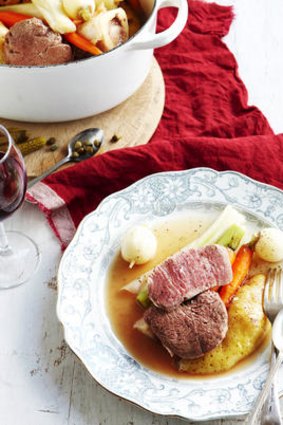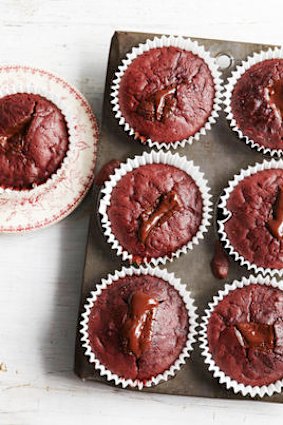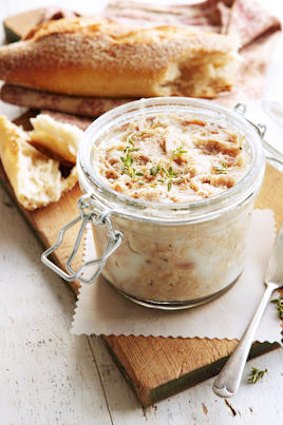Writing my memoirs has prompted me to think about the stages of my life, and these three recipes represent three important phases of it – my travel, especially my time in France, which influenced me in so many ways, my restaurant years and, now, my experiences as founder of the Stephanie Alexander Kitchen Garden Foundation.
I enjoy everything about cooking. The selection of fine produce, especially pulling the carrots or picking the beans from my own garden; exploring the potential of an ingredient; allowing myself to respond to what is happening in the pan or the pot without worrying about a recipe; and, of course, I love knowing that I can give great happiness to others when I cook for them.

Stephanie Alexander's Filet a la ficelle.Credit: Vanessa Levis
My new book is a memoir, not a record of my entire life, day by day. One of the strongest motives for writing it was that I wanted to tell the story of Australia’s food development, the importance of our migrants, and the rapid rise of restaurant culture from the late ’60s to today. I felt that as a practitioner for almost 40 years (on and off) I was in a very privileged position to comment on the changes I have seen and indeed influenced. To me, what has gone before ought to be part of the education of every new restaurateur, cook or service person.
At the end, I had to acknowledge that I am at my best when pursuing a project, and at my worst if I am without a project. I think the reader will read about me at my best and also at my worst. I know that I am curious about the next chunk of life.

Stephanie Alexander's beetroot and chocolate muffins.Credit: Vanessa Levis
Stephanie Alexander’s memoir, A Cook’s Life, is out now ($40, Lantern).
Filet à la ficelle
My interest in poached meat and poultry was piqued in simple French bistros, both in my student days and on later holidays. When I first tasted filet à la ficelle (“fillet on a string”) it was an absolute revelation.
6 x 6cm pieces marrow bone (ask butcher to prepare these)

Stephanie Alexander's Rillettes de Tours.Credit: Vanessa Levis
6 x 180g chunks well-aged beef fillet
1.5 litres well-flavoured veal stock
12 small carrots, peeled
6 small leeks, trimmed and well washed
6 small turnips, peeled
6 waxy potatoes (Kipfler, for example)
Salt and freshly ground black pepper
Soak marrow bones overnight in cold salted water. Next day, tie a piece of string around the centre of each chunk of beef, leaving a long end, then tie these long ends to the lid of a stockpot or saucepan. The idea is that the meat will be suspended in broth and not sitting on the bottom of the pot. Practise with the string, lid and pot before starting the recipe. Set oven to 75ºC and place a baking tray inside it. Preheat serving plates.
Simmer all vegetables in stock until tender. The potatoes will take longest. Scoop vegetables from stock and keep warm in baking tray in oven. Lower chunks of meat on their strings into simmering stock and settle lid on pot. Cook for 8 minutes, then remove lid, cut meat free and let it rest with vegetables in oven for at least 5 minutes.
Drop drained marrow bones into simmering stock for a few minutes. Return vegetables to stock to reheat. Slice each piece of beef in half to expose its rosy interior. Divide meat among heated plates. Surround beef slices with reheated vegetables, a piece of marrow bone and a ladle of broth. Serve with salt, pepper, Dijon mustard, and hot toast to spread the bone marrow on.
SERVES 6
Rillettes de Tours
A classic appetiser, rillettes are surprisingly easy to make. I tasted them for the first time in 1962-3 when I spent a year working at a teachers’ training college in Tours in the Loire Valley.
1.5kg fresh belly pork, not too lean, skinned and boned
1 tbsp salt, plus extra to season
1 bay leaf
1 large sprig thyme
2 cloves garlic, peeled
Freshly ground black pepper
MAKES 1½ CUPS
Cut meat into small pieces and rub in the 1 tbsp salt, then refrigerate for a few hours or overnight. Preheat oven to 150ºC. Put meat snugly into a cast-iron casserole and add herbs. Bury garlic in the centre. Grind on pepper and add ½ cup water. Cover with lid and cook for at least 3 hours until pork is swimming in its own juices and is completely tender. Tip into a colander resting over a clean basin. Discard herbs.
With scrupulously clean hands, shred meat and fat into another clean bowl. (Use 2 forks or your fingers.) The garlic will have almost dissolved. Mix it into meat, too. Strain juice over meat. Mix lightly but thoroughly and taste for seasoning. Rillettes should be very well seasoned; add more salt and pepper if necessary. Pack into 1 or more small pots, pressing well with a teaspoon to ensure there are no air pockets. Refrigerate until quite firm.
Rillettes will keep well in the refrigerator for a week if completely covered with a layer of fat.
Beetroot and chocolate muffins
Favourites with Kitchen Garden students, these muffins are child’s play to make!
250g raw beetroot
175g plain flour
1 tsp baking powder
2 tbsp cocoa powder
2 free-range eggs
¼ cup milk
60g softened butter
¼ cup vegetable oil
¼ cup caster sugar
½ cup soft brown sugar
100g best-quality dark chocolate
Lightly grease a 12-hole muffin tin, or drop paper cases into the holes. Preheat oven to 180ºC.
Peel beetroot and grate in a food processor with grating disc. Set aside and wash processor.
Sift flour, baking powder and cocoa into a large mixing bowl. Lightly whisk eggs with milk. Process butter, oil and sugars until creamy. Gradually add egg/milk mixture, alternating with flour mixture. Tip into the large bowl and stir in beetroot. Mix well. Spoon mixture into muffin holes. Break chocolate into 12 pieces and poke a piece into top of each muffin. Bake for 20-25 minutes until well-risen and springy to the touch. Cool in tin for a few minutes then turn onto a rack.
MAKES 12
Photography by Vanessa Levis. Styling by Bhavani Konings. Food preparation by Andrew De Sousa. Glass jar from Wheel & Barrow, (02) 9389 9022. All other props stylist’s own.
From: Sunday life